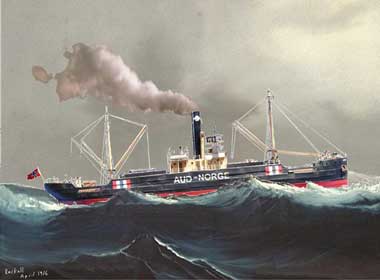AUD : Wiki Commons
Divers working this week to recover two anchors from the wreck of the 1916 German gun running ship, the Aud, located in Cobh Harbour have successfully retrieved the first of the anchors earlier today (Tuesday 19th June, 2012).
The diving operation has been licensed by Jimmy Deenihan TD, Minister for Arts Heritage and the Gaeltacht, under the National Monuments Acts. The dive team is led by County Waterford based diver, Mr. Eoin McGarry, and Tralee based archaeologist, Lar Dunne of Laurence Dunne Archaeology.
The Minister said that the recovery of the anchors was “very timely in that it will provide a tangible link between the two places most closely associated with the story of the Aud and the commemoration of the related events in 1916 that shaped the modern history of our nation.” He added that the story surrounding the capture and sinking of the Aud also highlights “the less talked about place of the 1916 Rising in the broader context of World War I and the conflicting loyalties the war gave rise to here in Ireland”.
Historical Context
The Aud was originally named the SS Castro when it was built in Kingston-Upon-Hull in 1910. At the outbreak of WW1 it was captured by the Germans and renamed the SMS Libau. In 1916 Sir Roger Casement secretly arranged for the transport of 20,000 captured Russian rifles, 10 machine guns and 5 million rounds of ammunition to Fenit Harbour, Tralee Bay, Co. Kerry to arm the Irish Volunteers. It was decided that Casement would travel to Fenit separately by U-Boat. The Libau was disguised as a Norwegian ship and renamed the Aud and the secret gun running mission was led by Captain Karl Spindler with a volunteer crew of 22.

After an amazing circuitous journey from Lubeck as far as the Arctic Circle the Aud steamed south past Rockall and along the west coast of Ireland. Having successfully evaded a number of British Navy patrols the Aud anchored off the Magharee Islands in Tralee Bay on Holy Thursday the 20th April 1916.
For a number of reasons the Aud never landed its cargo and Casement who was landed by U-Boat U-19 at Banna Strand never rendezvoused with it and was himself almost immediately captured. After leaving Tralee Bay the Aud was captured by a British Naval flotilla off the SW coast of Ireland and escorted to Cobh (Queenstown) in Cork. At the entrance to Cork Harbour, not far from Daunts Rock, Spindler and his crew donned their German Kriegsmarine uniforms and ran up their colours before scuttling the Aud . They were subsequently interned for the rest of the war.
Both anchors are destined for display in suitable locations, one to be provided by Tralee and Fenit Harbour Commissioners and the other by Cobh Town Council. The conservation process will take approximately two years and the anchors will be ready to be shown to the public in time for the centenary of the 1916 Rising. The Minister welcomed the initiative of everyone involved in the recovery of the anchors and thanked the Tralee and Fenit Harbour Commissioners and Cobh Town Council for providing suitable long-term display facilities. He added that “special tribute was due to the Fenit Heritage Association which is funding the conservation work”.
A documentary about the Aud is also being undertaken and filming of the raising of the anchors will take place in association with George Clayton who has published a book on the Aud and who is also a member of the recovery expedition. Two descendants of the crew of the Aud, John and Fred Schmitz, will also be in attendance having travelled from New Jersey for this historic archaeological occasion.
The anchors will be conserved under licence from the National Museum of Ireland by Laurence Dunne Archaeology in their conservation facility. Full access to the anchors will be provided to the Receiver of Wrecks into whose care they will be given. Otherwise, bona fide access to the anchors can be made through contact with Laurence Dunne and Eoin McGarry.
An initial assessment and primary conservation work will be carried out on the anchors by Laurence Dunne and Ian Panter, Chief Conservator with York Archaeological Trust next week. It is estimated that the conservation process will take at least three years to complete.
It is intended that following conservation one of the anchors will be put in contextualised indoor display in Cobh and the other anchor in a similar setting in Fenit Port in time for the centenary celebrations of the dramatic events of the Aud and the declaration of Irish Independence of Easter 1916.
The wreck of the Aud belongs to the State and, while the artefacts will be on display in Cobh and Fenit, they remain the property of the Irish State.




